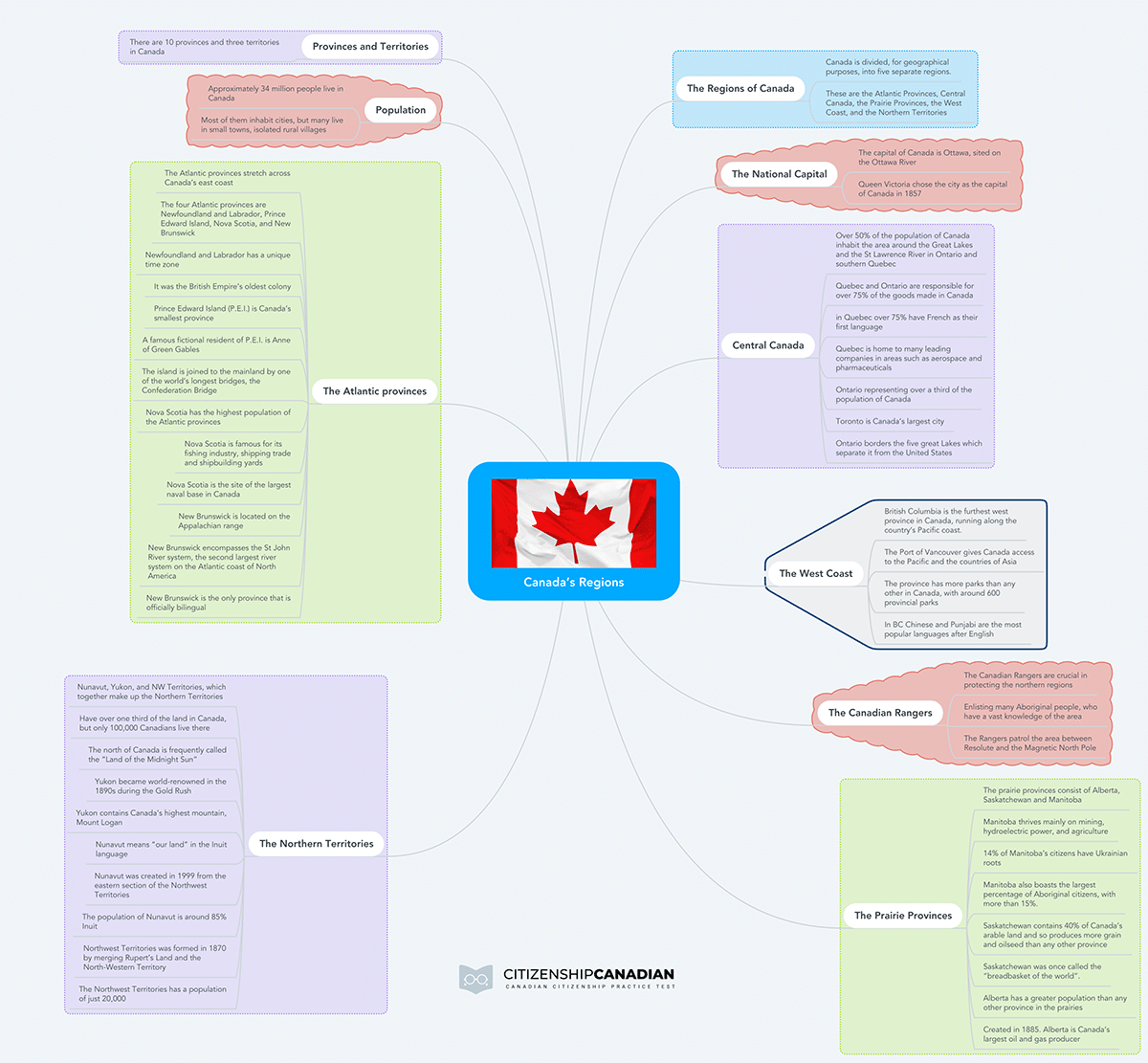1 The Regions of Canada
1.1 Canada is divided, for geographical purposes, into five separate regions.
1.2 These are the Atlantic Provinces, Central Canada, the Prairie Provinces, the West Coast, and the Northern Territories
2 The National Capital
2.1 The capital of Canada is Ottawa, sited on the Ottawa River
2.2 Queen Victoria chose the city as the capital of Canada in 1857
3 Central Canada
3.1 Over 50% of the population of Canada inhabit the area around the Great Lakes and the St Lawrence River in Ontario and southern Quebec
3.2 Quebec and Ontario are responsible for over 75% of the goods made in Canada
3.3 in Quebec, over 75% have French as their first language
3.4 Quebec is home to many leading companies in areas such as aerospace and pharmaceuticals
3.5 Ontario representing over a third of the population of Canada
3.6 Toronto is Canada’s largest city
3.7 Ontario borders the five Great Lakes, which separate it from the United States
4 The West Coast
4.1 British Columbia is the furthest west province in Canada, running along the country’s Pacific coast.
4.2 The Port of Vancouver gives Canada access to the Pacific and the countries of Asia
4.3 The province has more parks than any other in Canada, with around 600 provincial parks
4.4 In BC, Chinese and Punjabi are the most popular languages after English
5 The Canadian Rangers
5.1 The Canadian Rangers are crucial in protecting the northern regions
5.2 Enlisting many Aboriginal people, who have a vast knowledge of the area
5.3 The Rangers patrol the area between Resolute and the Magnetic North Pole
6 The Prairie Provinces
6.1 The prairie provinces consist of Alberta, Saskatchewan, and Manitoba
6.2 Manitoba thrives mainly on mining, hydroelectric power, and agriculture
6.3 14% of Manitoba’s citizens have Ukrainian roots
6.4 Manitoba also boasts the largest percentage of Aboriginal citizens, with more than 15%.
6.5 Saskatchewan contains 40% of Canada’s arable land, and so produces more grain and oilseed than any other province
6.6 Saskatchewan was once called the “breadbasket of the world”.
6.7 Alberta has a greater population than any other province in the prairies
6.8 Created in 1885. Alberta is Canada’s largest oil and gas producer
7 The Northern Territories
7.1 Nunavut, Yukon, and NW Territories, which together make up the Northern Territories
7.2 Have over one-third of the land in Canada, but only 100,000 Canadians live there
7.3 The north of Canada is frequently called the “Land of the Midnight Sun.”
7.4 Yukon became world-renowned in the 1890s during the Gold Rush
7.5 Yukon contains Canada’s highest mountain, Mount Logan
7.6 Nunavut means “our land” in the Inuit language
7.7 Nunavut was created in 1999 from the eastern section of the Northwest Territories
7.8 The population of Nunavut is around 85% Inuit
7.9 Northwest Territories was formed in 1870 by merging Rupert’s Land and the North-Western Territory
7.10 The Northwest Territories has a population of just 20,000
8 The Atlantic provinces
8.1 The Atlantic provinces stretch across Canada’s east coast
8.2 The four Atlantic provinces are Newfoundland and Labrador, Prince Edward Island, Nova Scotia, and New Brunswick
8.3 Newfoundland and Labrador has a unique time zone
8.4 It was the British Empire’s oldest colony
8.5 Prince Edward Island (P.E.I.) is Canada’s smallest province
8.6 A famous fictional resident of P.E.I. is Anne of Green Gables
8.7 The island is joined to the mainland by one of the world’s longest bridges, the Confederation Bridge
8.8 Nova Scotia has the highest population of the Atlantic provinces
8.9 Nova Scotia is famous for its fishing industry, shipping trade, and shipbuilding yards
8.10 Nova Scotia is the site of the largest naval base in Canada
8.11 New Brunswick is located on the Appalachian range
8.12 New Brunswick encompasses the St John River system, the second largest river system on the Atlantic coast of North America
8.13 New Brunswick is the only province that is officially bilingual
9 Provinces and Territories
9.1 There are ten provinces and three territories in Canada
10 Population
10.1 Approximately 34 million people live in Canada
10.2 Most of them

